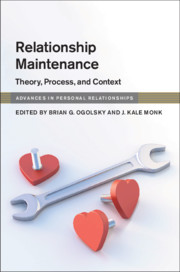Book contents
- Relationship Maintenance
- Advances in Personal Relationships
- Relationship Maintenance
- Copyright page
- Contents
- Tables
- Figures
- Contributors
- Part I Introduction
- Part II Theories of Relationship Maintenance
- Part III Processes of Relationship Maintenance
- 7 Communication and Relationship Maintenance
- 8 Attributions, Forgiveness, and Gratitude as Relationship Maintenance Processes
- 9 Social Networks and Relationship Maintenance
- 10 Dyadic Coping as Relationship Maintenance
- 11 Conflict Management and Problem Solving as Relationship Maintenance
- 12 Sex as Relationship Maintenance
- 13 Accuracy and Bias in Relationship Maintenance
- Part IV The Social Context of Relationship Maintenance
- Part V Conclusion
- Index
- References
9 - Social Networks and Relationship Maintenance
from Part III - Processes of Relationship Maintenance
Published online by Cambridge University Press: 02 December 2019
- Relationship Maintenance
- Advances in Personal Relationships
- Relationship Maintenance
- Copyright page
- Contents
- Tables
- Figures
- Contributors
- Part I Introduction
- Part II Theories of Relationship Maintenance
- Part III Processes of Relationship Maintenance
- 7 Communication and Relationship Maintenance
- 8 Attributions, Forgiveness, and Gratitude as Relationship Maintenance Processes
- 9 Social Networks and Relationship Maintenance
- 10 Dyadic Coping as Relationship Maintenance
- 11 Conflict Management and Problem Solving as Relationship Maintenance
- 12 Sex as Relationship Maintenance
- 13 Accuracy and Bias in Relationship Maintenance
- Part IV The Social Context of Relationship Maintenance
- Part V Conclusion
- Index
- References
Summary
Relationships are embedded in broader social networks, including the family and friends of both partners. Covering contributions from several disciplines, this chapter discusses the role of social networks in the maintenance of intimate relationships. We first describe findings from the communication field showing how people use their social networks (such as through doing activities with mutual friends) as one of several strategies to maintain their relationships. Then, we discuss social psychological literature regarding how social networks affect both dyad members’ motivation to engage in various maintenance mechanisms that follow from their decision to commit. Furthermore, the social network can be instrumental in influencing pair members’ ability to maintain their relationship, including by giving advice to help repair relationships, which is also discussed in this chapter. We then turn to more macro-level issues regarding the compositional or structural dimensions of social networks and the ways in which they play a role in the maintenance of couples’ relationships. Variation in the processes of network influence on the maintenance of relationships is also considered, including how networks differentially influence relationship maintenance across the life course and through technology (e.g., social media).
Keywords
- Type
- Chapter
- Information
- Relationship MaintenanceTheory, Process, and Context, pp. 152 - 177Publisher: Cambridge University PressPrint publication year: 2019
References
- 2
- Cited by

